Schipkov: Dutch
Defence A89
1.d4 f5
2.c4
Nf6
3.Nf3
g6 4.g3
Bg7
5.Bg2
0-0 6.0-0 d6 7.Nc3
Nc6
8.d5
Na5
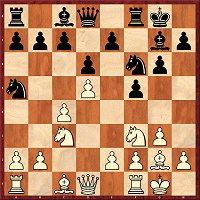 |
|
This line from the Leningrad System still remains playable for
Black. The most frequent replies 9.Nd2
and 9.Qd3
are hardly a challenge to it; the most interesting is the
exchange sacrifice 9.b3, but there is no need to accept it. |
Kritz: Sicilian
Defence B30
1.e4 c5 2.Nf3
Nc6
3.Nc3
Nf6
4.Bb5
g6
|
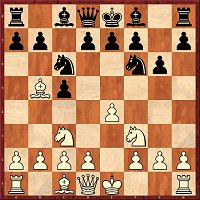
|
|
After 3.Nc3
the option of d2-d4 remains open and if Black wants a
Sveshnikov, he must reply 3...Nf6;
after 4.Bb5
White then plays a sort of Rossolimo plus
Nc3/Nf6.
According to Leonid Kritz he achieves a paper-thin advantage in
the variation with 4...g6.
|
Grivas:
Sicilian
Defence B33
1.e4 c5 2.Nf3
Nc6
3.d4 cxd4 4.Nxd4
Qb6
5.Nb3
Nf6
6.Nc3
e6 7.Bd3
d6 8.0-0 a6 9.Kh1
Be7
10.f4
Qc7
11.Bd2
b5
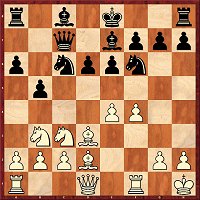 |
|
In the Apollo Variation which is dealt with, the similarity to
the Scheveningen System cannot be overlooked. But the slight
differences tend to favour Black and so what we have here is not
a critical variation. |
Karoly: Sicilian
Defence B90
1.e4 c5 2.Nf3
d6 3.d4 cxd4 4.Nxd4
Nf6
5.Nc3
a6 6.Be3
e5 7.Nde2
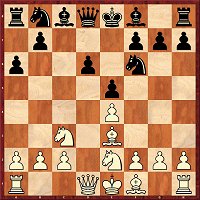 |
|
Liviu-Dieter Nisipeanu has had a few nice successes with 7.Nde2.
In his article the author presents a detailed analysis of all
the lines. Usually the structures which occur are less typical
than those in other lines of the Najdorf. |
Stohl: Queen's Gambit
Accepted D27
1.d4 d5 2.c4 dxc4 3.Nf3
Nf6
4.e3 e6 5.Bxc4
c5 6.0-0 a6 7.Bb3
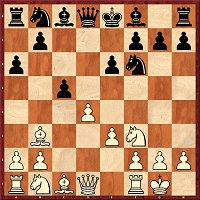 |
|
In the second and final part of his repertoire for White based
on 7.Bb3
Igor Stohl investigates above all the moves 7...Nc6
and 7...Be7
as well as 7...cxd4, with their many transpositions. |
Breutigam: Semi-Slav
D43/D44
1.d4 d5 2.c4 c6 3.Nf3
Nf6
4.Nc3
e6 5.Bg5
dxc4 6.e4 b5 7.e5 h6 8.Bh4
g5 9.Bg3
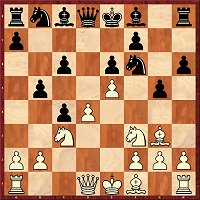 |
|
The same position is also reached after 5...h6 6.Bh4
dxc4 7.e4 g5 8.Bg3
b5 9.e5. So if one can make the variation playable, it will form
a weapon against two different systems at the same time. Martin
Breutigam shows that promising positions can be reached. |
Schandorff: Queen's
Gambit D52
1.d4 d5 2.c4 c6 3.Nf3
Nf6
4.Nc3
e6 5.Bg5
Nbd7
6.e3
Qa5 7.cxd5
Nxd5
8.Qd2
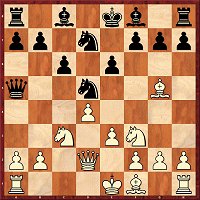 |
|
In his second contribution on the Cambridge Springs Variation
Lars Schandorff points out that Black does not have an easy life
in the side lines 8...N7b6
and 8...Bb4
9.Rc1
e5 or 9...0-0. |
Kuzmin: Queen's Gambit
D53
1.d4 d5 2.c4 e6 3.Nf3
Nf6
4.Nc3
Be7
5.Bg5
h6 6.Bxf6
Bxf6
7.Qb3
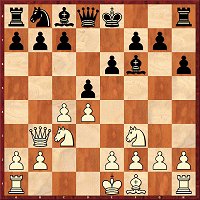 |
|
This side variation has above all been played successfully by
top Chinese player Bu Xiangzhi. There may be no way to prove
conclusively an opening advantage for White, but most players
are content enough with a little pressure. |
Avrukh:
Grünfeld Defence D90
1.d4
Nf6
2.c4 g6 3.Nc3
d5 4.Nf3
Bg7
5.Qa4+
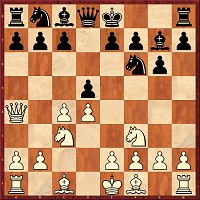 |
|
In the main variation 5...Bd7
6.Qb3
dxc4 7.Qxc4
0-0 8.Bf4
White tries to prove that compared with the 5.Qb3
variation the
Bd7
is not so well placed. Perhaps it is then possible to get a
mini-advantage. |
Postny:
Slav/Grünfeld Defence D94
1.d4 d5 2.c4 c6 3.Nf3
Nf6
4.Nc3
g6 5.e3
Bg7
6.Be2
0-0 7.0-0 e6
 |
|
In the side variation 7...e6 too, you get what is mostly there
for Black in the Schlechter Variation: a playable position which
is almost level. |
Marin: Bogo-Indian
Defence E11
1.d4
Nf6
2.c4 e6 3.Nf3
Bb4+
4.Nbd2
d5 5.Qa4+
Nc6
6.a3
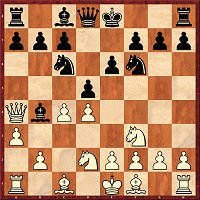 |
|
In the position in the diagram our author examines the moves
6...Bxd2+
and 6...Be7.
Although something can be said in favour of the exchange, Mihail
Marin does prefer the retreat. It is not easy for White to
obtain an advantage. |
Anic: King's Indian
E67
1.d4
Nf6
2.c4 g6 3.Nf3
Bg7
4.g3 0-0 5.Bg2
d6 6.0-0
Nbd7
7.Nc3
e5 8.h3 exd4 9.Nxd4
Nb6
10.b3 d5
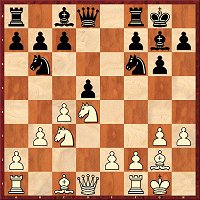 |
|
White plays 8.h3, because it is always a useful move and then
unlike with 8.e4 the line 8...a6 would be favourable (9.dxe5
dxe5 10.Be3!).
But the sequence of moves which leads to the diagram seems to
give Black sufficient play. |
Kuzmin: King's Indian
E73
1.d4
Nf6
2.c4 g6 3.Nc3
Bg7
4.e4 d6 5.Be2
0-0 6.Be3
e5 7.d5
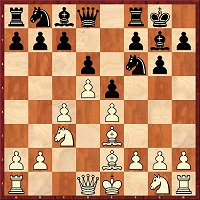 |
|
With this setup, which is related to the Averbakh System, White
is planning an immediate kingside advance by means of g2-g4; the
development of the
Ng1
is temporarily delayed. |